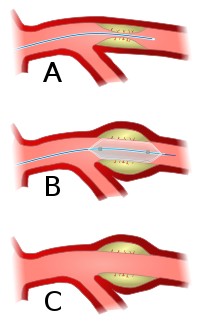
Angioplasty, also known as balloon angioplasty and percutaneous transluminal angioplasty (PTA), is a minimally invasive endovascular procedure used to widen narrowed or obstructed arteries or veins, typically to treat arterial atherosclerosis. A deflated balloon attached to a catheter is passed over a guide-wire into the narrowed vessel and then inflated to a fixed size. The balloon forces expansion of the blood vessel and the surrounding muscular wall, allowing an improved blood flow. A stent may be inserted at the time of ballooning to ensure the vessel remains open, and the balloon is then deflated and withdrawn. Angioplasty has come to include all manner of vascular interventions that are typically performed percutaneously.
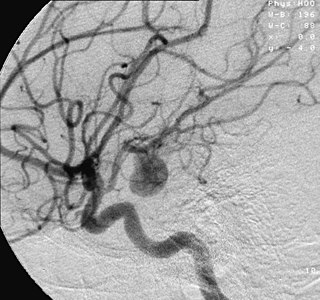
An aneurysm is an outward bulging, likened to a bubble or balloon, caused by a localized, abnormal, weak spot on a blood vessel wall. Aneurysms are a result of a weakened blood vessel wall, and may be a result of a hereditary condition or an acquired disease. Aneurysms can also be a nidus for clot formation (thrombosis) and embolization. The word is from Greek: ἀνεύρυσμα, aneurysma, "dilation", from ἀνευρύνειν, aneurynein, "to dilate". As an aneurysm increases in size, the risk of rupture increases, leading to uncontrolled bleeding. Although they may occur in any blood vessel, particularly lethal examples include aneurysms of the Circle of Willis in the brain, aortic aneurysms affecting the thoracic aorta, and abdominal aortic aneurysms. Aneurysms can arise in the heart itself following a heart attack, including both ventricular and atrial septal aneurysms. There are congenital atrial septal aneurysms, a rare heart defect.

Interventional radiology (IR) is a medical subspecialty that performs various minimally-invasive procedures using medical imaging guidance, such as x-ray fluoroscopy, computed tomography, magnetic resonance imaging, or ultrasound. IR performs both diagnostic and therapeutic procedures through very small incisions or body orifices. Diagnostic IR procedures are those intended to help make a diagnosis or guide further medical treatment, and include image-guided biopsy of a tumor or injection an imaging contrast agent into a hollow structure, such as a blood vessel or a duct. By contrast, therapeutic IR procedures are those which provide direct treatment, and include catheter-based delivery of medicine, placement of medical devices, and angioplasty of narrowed structures.
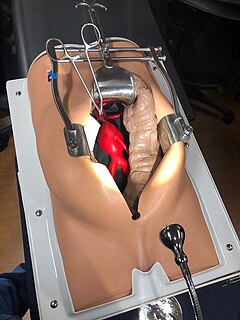
Vascular surgery is a surgical subspecialty in which diseases of the vascular system, or arteries, veins and lymphatic circulation, are managed by medical therapy, minimally-invasive catheter procedures, and surgical reconstruction. The specialty evolved from general and cardiac surgery as well as minimally invasive techniques pioneered by interventional radiology. The vascular surgeon is trained in the diagnosis and management of diseases affecting all parts of the vascular system excluding the coronaries and intracranial vasculature.

An aortic aneurysm is an enlargement (dilatation) of the aorta to greater than 1.5 times normal size. They usually cause no symptoms except when ruptured. Occasionally, there may be abdominal, back, or leg pain.
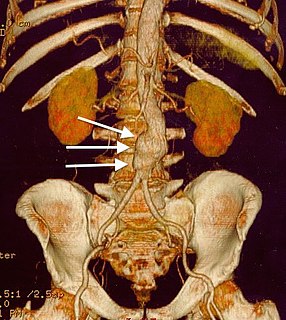
Abdominal aortic aneurysm is a localized enlargement of the abdominal aorta such that the diameter is greater than 3 cm or more than 50% larger than normal. They usually cause no symptoms, except during rupture. Occasionally, abdominal, back, or leg pain may occur. Large aneurysms can sometimes be felt by pushing on the abdomen. Rupture may result in pain in the abdomen or back, low blood pressure, or loss of consciousness, and often results in death.

A thoracic aortic aneurysm is an aortic aneurysm that presents primarily in the thorax.

In medicine, aortoiliac occlusive disease, is a form of central artery disease involving the blockage of the abdominal aorta as it transitions into the common iliac arteries.

Cordis develops and manufactures medical devices for diagnostics and interventional procedures to treat patients suffering from coronary and peripheral vascular diseases.
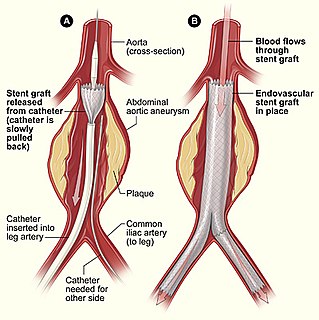
Endovascular aneurysm repair (EVAR), is a type of endovascular surgery used to treat pathology of the aorta, most commonly an abdominal aortic aneurysm (AAA). When used to treat thoracic aortic disease, the procedure is then specifically termed TEVAR for "thoracic endovascular aortic/aneurysm repair." The procedure involves the placement of an expandable stent graft within the aorta to treat aortic disease without operating directly on the aorta. In 2003, EVAR surpassed open aortic surgery as the most common technique for repair of AAA, and in 2010, EVAR accounted for 78% of all intact AAA repair in the United States.
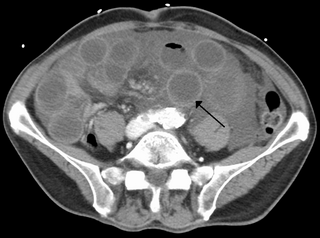
Mesenteric ischemia is a medical condition in which injury to the small intestine occurs due to not enough blood supply. It can come on suddenly, known as acute mesenteric ischemia, or gradually, known as chronic mesenteric ischemia. The acute form of the disease often presents with sudden severe abdominal pain and is associated with a high risk of death. The chronic form typically presents more gradually with abdominal pain after eating, unintentional weight loss, vomiting, and fear of eating.
Michael L. Marin is an American vascular surgeon, the first in the United States to perform minimally invasive aortic aneurysm surgery together with Drs. Frank Veith, Juan C. Parodi and Claudio J. Schonholz.
Julio Palmaz is a doctor of vascular radiology at University of Texas Health Science Center at San Antonio. He studied at the National University of La Plata in Argentina, earning his medical degree in 1971. He then practiced vascular radiology at the San Martin University Hospital in La Plata before moving to the University of Texas Health and Science Center at San Antonio. He is known for inventing the balloon-expandable stent, for which he received a patent filed in 1985. It was recognized in Intellectual Property International Magazine as one of "Ten Patents that Changed the World" in the last century. His early stent research artifacts are now part of the medical collection of the Smithsonian Institution in Washington, DC. He continues to innovate on his initial designs, developing new endovascular devices.
Purshotam Lal is an Indian cardiologist and chairman and director of Interventional Cardiology of the Metro Group of Hospitals. He has been awarded the Padma Vibhushan (2009), Padma Bhushan, and Padma Shree. He specializes in non-surgical closure of heart holes (ASD/VSD), non-surgical replacement of valves, and treatment of multiple sclerosis.
A hybrid cardiac surgical procedure in a narrow sense is defined as a procedure that combines a conventional surgical part with an interventional part, using some sort of catheter-based procedure guided by fluoroscopy imaging in a hybrid OR without interruption. A wider definition includes a clinically connected succession of a catheter intervention and a surgical procedure with a time gap.
Endovascular Surgical Neuroradiology (ESN), also known as Neurointerventional Surgery (NIS), Interventional Neuroradiology (INR), and Endovascular Neurosurgery, is a medical subspecialty of Neurology, Neurosurgery, and radiology specializing in minimally invasive image-based technologies and procedures used in diagnosis and treatment of diseases of the head, neck, and spine.

Open aortic surgery (OAS), also known as open aortic repair (OAR), describes a technique whereby an abdominal or retroperitoneal surgical incision is used to visualize and control the aorta for purposes of treatment. OAS is used to treat aneurysms of the abdominal and thoracic aorta, aortic dissection, acute aortic syndrome, and aortic ruptures. Aortobifemoral bypass is also used to treat atherosclerotic disease of the abdominal aorta below the level of the renal arteries. In 2003, OAS was surpassed by endovascular aneurysm repair (EVAR) as the most common technique for repairing abdominal aortic aneurysms in the United States. In OAS for abdominal aortic aneurysm, the aneurysmal portion of the aorta is replaced with a graft, usually made of dacron or PTFE.
Frank J. Veith is an American vascular surgeon who serves as Professor of Surgery, New York University Medical Center NY, NY and Professor of Surgery Cleveland Clinic Lerner College of Medicine of Case Western Reserve University, Cleveland, OH. He was the first vascular surgeon in the United States to perform minimally invasive aortic aneurysm surgery together with Drs. Michael L. Marin, Juan C. Parodi and Claudio J. Schonholz.
Juan Carlos Parodi is an Argentinian vascular surgeon, the first in the United States to perform minimally invasive aortic aneurysm surgery together with Drs. Frank Veith, Michael L. Marin and Claudio J. Schonholz. He is considered a pioneer in the field of endovascular repairs of the aorta. Developer of Seat belt and air bag technique for cerebral protection during carotid stenting.
Endovascular and hybrid trauma and bleeding management is a new and rapidly evolving concept within medical healthcare and endovascular resuscitation. It involves early multidisciplinary evaluation and management of hemodynamically unstable patients suffering from traumatic injuries as well as being a bridge to definitive treatment. It has recently been shown that the EVTM concept may also be applied to non-traumatic hemodynamically unstable patients.










